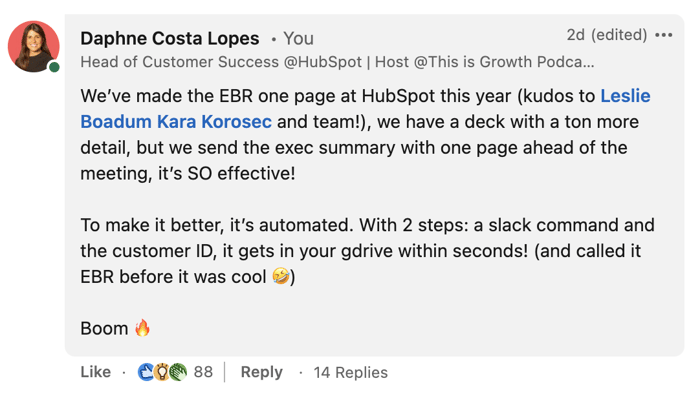#33: Maximise the adoption of your CS Playbooks
Earlier this week I commented on a LinkedIn post by Greg Daines about the amazing automated EBR resource that we created at HubSpot and it lit up the channel 🔥

But it's what happened next that really surprised me.
I got a series of DMs from HubSpot customers saying they had never seen this awesome resource and that they would love to get their hands on their personalised version.
I assumed these were our smallest customers that don't have a CSM and for that reason don't really get this type of content. So I went to the CRM to check it and surprise, surprise...
Some of these were pretty meaningful customers with assigned CSMs 💩
I was left thinking: What would prevent a high-touch CSM from leveraging an automated resource like this for every single customer?
Despite having a bias as I led the team creating this resource, I know that in general, I am not alone here.
I have heard from CS leaders countless times that they struggle to get their CSMs to adopt new resources, even when they make the job faster, easier and more impactful.
Why does it happen?
So I asked a few CSMs and here is what they told me:
- We have too many playbooks and docs, it's hard to know what to use when
- We are not always confident when delivering executive meetings
- It's hard to prioritise these types of proactive conversations when there are urgent customer issues to work on
Upon reflection, I have 3 lessons that we can all start implementing today to help drive better adoption of critical resources such as this automated EBR.
- Clean up your CS resources: Archive old playbooks or those that haven't demonstrated tangible impact. Surface all the high-value resources and ensure they are centralised, easy to find and that they connect to the stages of your customer journey. Knowing when to use resources is as important as knowing what to use.
- Organise Real-Plays: What makes it a "real" play is that instead of creating a fake customer as is common in role plays, you ask a CSM to prepare for it using a real customer case. Then you pair up people to run these (one person plays the customer, the other the CSM). This should help build their confidence in a safe space. Every time I have used a real-play with a CSM, they have learned more than in a classroom setting.
- Proactive Alert System: Flag customers that need proactive outreach for CSMs in a way that's easy to visualise and prioritise that work. This type of system also gives managers visibility into how a CSM is spending their time and helps coach those who are struggling to fit their proactive work. (learn more here)
Simple steps when executed right can help maximise the adoption of key resources.
Wish me luck and see you next Friday :D
-3.png?width=200&height=88&name=This%20is%20growth%20(1)-3.png)
.png)
.png)
-1.png)